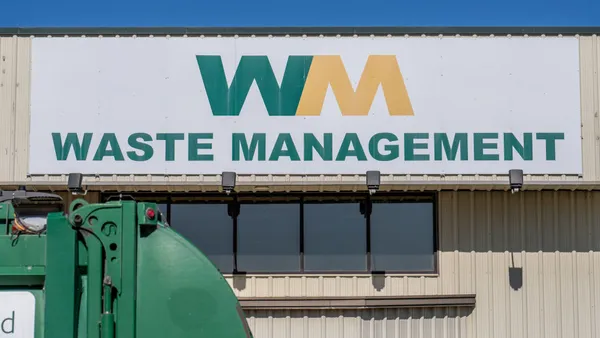Dive Brief:
- The rate of workplace fatalities among “refuse and recyclable material collectors” declined year over year in 2019, ranking sixth among deadliest occupations, according to newly released data from the U.S. Department of Labor’s Bureau of Labor Statistics (BLS).
- For every 100,000 full-time collection workers, there were 35.2 fatal work injuries, down from a rate of 42 in 2018. Ultimately, there were 43 fatalities in the related "solid waste collection" category for 2019 – 26 of which were due to transportation incidents. This was down significantly from 2018's spike to 57 fatalities, including 44 transportation incidents.
- It's the first time since 2012 collection workers haven’t landed in the top five most fatal occupations. Still, at number six, “no one should be taking any victory laps,” said David Biderman, CEO of the Solid Waste Association of North America (SWANA).
Dive Insight:
The lower number of collection worker fatalities in 2019, and an apparent drop in transportation incidents, is seen as welcome news for the industry. Construction trade worker fatality rates overtook those of waste collectors for the fifth spot on the BLS list.
Nonetheless, it was a mixed year for the safety records of various professions in the waste industry. BLS reported last month the injury and illness rate for collection workers was flat between 2018 and 2019, at 5.5 incidents per 100 full-time employees. Solid waste collection workers, specifically, were noted as among the most likely professionals to experience incidents resulting in "days away from work, restricted work activity, or job transfer."
For solid waste landfill workers, the injury and illness rate rose from 3.9 to 4.9. Although BLS reported no landfill fatalities in 2019, SWANA, which covers both the U.S. and Canada, said in a press release Wednesday its internal data showed 11 landfill fatalities for the year. At MRFs, BLS-recorded fatalities held flat at three in both 2018 and 2019 and the rate of injury and illness fell from 4.9 to 3.6.

"[W]e will never accept any loss of life," said National Waste and Recycling Association (NWRA) CEO Darrell Smith. "We are pleased, however, that our industry has become safer."
Former U.S. OSHA head David Michaels, a professor at George Washington University’s School of Public Health, noted in an email that while "The rate of fatal injuries among workers in this industry is still very high ... I know many in the industry have been working hard to prevent serious injuries; these numbers suggest their efforts are beginning to pay off."
NWRA highlighted some of those efforts in a press release Wednesday, including the proliferation of “Slow Down to Get Around” laws, stipulating motorists use caution when waste collection workers are working outside of their trucks.
This year, some safety education efforts have been disrupted by the coronavirus pandemic, including many of SWANA’s hauler outreach events. Biderman said the organization hopes for widespread resumption of such programs in 2021.
As for 2020 numbers, SWANA said it expects to report a further decline in fatalities when it shares its data in February. Around the midpoint of 2020, it appeared the pandemic's influence in decreasing traffic on the roads may be contributing to fewer vehicular incidents.
Across all the occupations BLS tracks, the rate of fatal work injuries in 2019 held steady at 3.5 per 100,000 full-time workers, but the actual number of fatalities reached 5,333, the highest count since 2007. Other notable increases included a 13% rise in fatalities among Hispanic or Latino workers to 1,088 total, a high since 1992.










